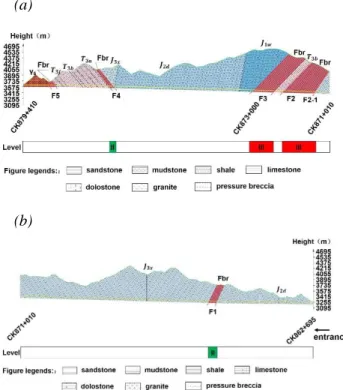D305
On the Classification of Large Deformation for a Tunnel Under High Geo-stress
〇Shengshan Wu, Xiaoyan Zhao, Gonghui Wang
1. Introduction
For the construction of railway in Tibet, China, a long and deep-buried tunnel is planned and will be built. This tunnel will across the area with complex geological conditions and high geo-stress. Large deformation will be expected to occur as a common geological hazard for the tunnel construction under such high geo-stress. Therefore, proper prediction and classification of the planning tunnel (about 20 km long) will be needed such that a theoretical reference could be provided for the design of supporting structures. There are two key issues involving in the classification of large deformation. The first one is the geo-stress around the tunnel. In recent decades, many studies, such as geological analysis, ground stress measurement, numerical analysis and simulation, etc., had been conducted for better understanding the high geo-stress, and the classifications of geo-stress had been proposed (as listed in Table 1). The second issue is the buildup of a suitable criterion for the classification of large deformation, based on the geo-stress. However, the definition of large deformation is controversial in differing studies based on different projects. For example, different coefficients, such as strength-stress ratio, deformation displacement, original stress, and relative distortion level, etc., had been proposed and used as the criterion for the large deformation.
To provide more reliable evidences for the tunnel under high geo-stress environment, in this study we aim at classifying the large deformation of this tunnel combining its geological conditions and in-situ stress data. We present the simulation results of
geo-stress and the classification of large deformation.
Table. 1 Classifications of geo-stress
Geo-stress level AFTES JSEG Donbass Mining Association of SSSR General >4 >4 >4 high 2-4 2-4 2.2-4 Extreme-high <2 <2 <2.2 2. Methods
It is well understood that based on measured geo-stress data, the 3-D numerical simulation could be an effective method to estimate the distribution of geo-stress. In order to simulating geo-stress more accurately, we collected all the geological data, such as geological conditions, profile of the tunnel, and borehole data, etc., through site investigation. Then we conducted a 3-D numerical simulation to acquire the distribution of geo-stress around the tunnel area. Because it will be essential to choose the criterion properly for the classification of large deformation, we used strength-stress ratio (𝑅𝑏/𝜎𝑚𝑎𝑥) of the rock as the index for this
uncompleted tunnel, which is under high geo-stress geological environment.
3. Results
Regression analysis on the borehole data reveals that the lateral pressure coefficient (KH) becomes smaller with increase of depth (Fig.1), and it results in a relationship as: 𝐾𝐻 = 𝑆𝐻 𝑆𝑣 = 118.74 𝐻 + 1.13 (1)
where SH is maximum principal stress, and SV is normal stress. The maximum principal stress at 1150 m is
estimated to be 36.71 MPa according to equation (1).
Fig.1 Fitting curve of measured geo-stress
The geo-stress distributions for the whole tunnel obtained from the numerical simulation are shown in Fig. 2. As noticed, the stresses near the tunnel entrance are small, and the maximum value of the maximum principal stress is 36.96 MPa, showing good consistency with the regression analysis.
Fig. 2 Distribution of Geo-stress along the tunnel
Finally, based on the geo-stress distribution and the proposed criterion for the tunnel, detailed classification and segmentation analysis of large deformation along the tunel were carried out and the results are shown in Fig. 3, there the zone and level of the large deformation could be identified obviously.
(a)
(b)
Fig. 3 Classification results of large deformation (a): For the area of CK879+410~CK871+010 (b): For the area of CK871+010~ CK862+695
4. Conclusions
A detailed numerical modelling approach was proposed for simulating the geo-stress distribution of a tunnel locating on a geoenviroment with high geostress in Tibet, China. Based on the filed investigation and numberial simulation results, the classification of large deformation was conducted. Our results could be sumamrized as follows:
(1) In the tunnel area, the direction of maximum principal stress is horizontal, and the value is estimated to be about 3.81~36.96 MPa by simulation, which shows good consistency with the in-situ measured data. (2) The simulation results reveal that 10.35% of the tunnel could be classified into large deformation zone, 1.91% of which is in level II, and 8.44% is in level III. However, there is no section that could be classified into level I and level IV.
